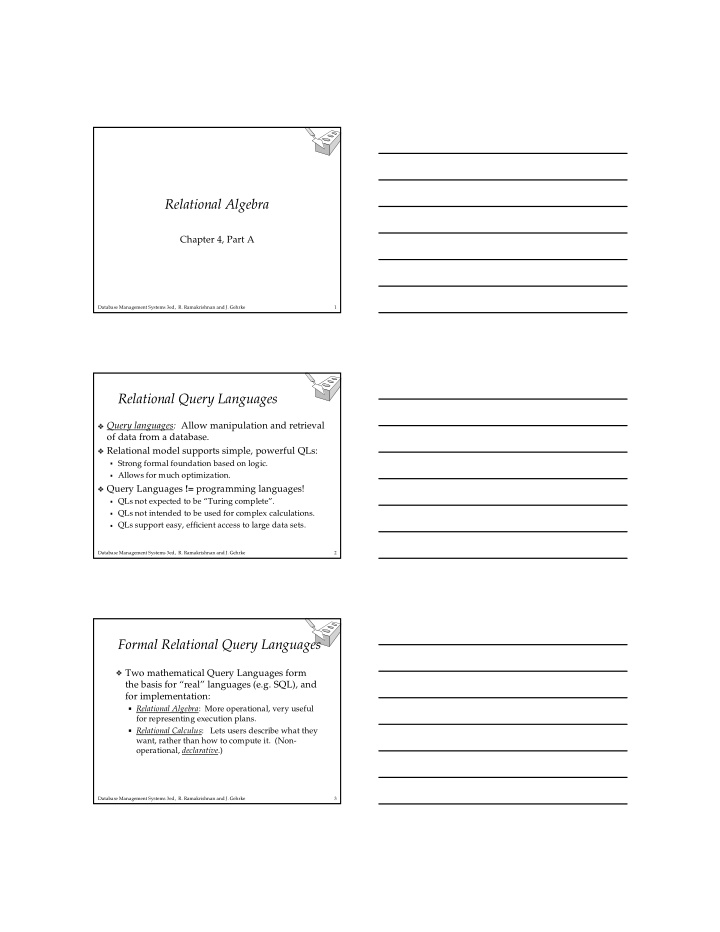



� ✁ ✂ ✂ ✁ � ✁ � � ✁ ✁ Relational�Algebra Chapter�4,�Part�A Database�Management�Systems�3ed,��R. Ramakrishnan and�J.�Gehrke 1 Relational�Query�Languages Query�languages:� Allow�manipulation�and�retrieval� of�data�from�a�database. Relational�model�supports�simple,�powerful QLs: Strong�formal�foundation�based�on�logic. Allows�for�much�optimization. Query�Languages� != programming�languages! QLs not�expected�to�be�“Turing�complete”. QLs not�intended�to�be�used�for�complex�calculations. QLs support�easy,�efficient�access�to�large�data�sets. Database�Management�Systems�3ed,��R. Ramakrishnan and�J.�Gehrke 2 Formal�Relational�Query�Languages Two�mathematical�Query�Languages�form� the�basis�for�“real”�languages�(e.g.�SQL),�and� for�implementation: Relational�Algebra :��More�operational,�very�useful� for�representing�execution�plans. Relational�Calculus :���Lets�users�describe�what�they� want,�rather�than�how�to�compute�it.��(Non- operational,� declarative .) Database�Management�Systems�3ed,��R. Ramakrishnan and�J.�Gehrke 3
✁ � � ✁ ✁ ✁ ✁ ✁ � ✁ � ✁ ✁ � ✁ � ✁ � Preliminaries A�query�is�applied�to� relation�instances ,�and�the� result�of�a�query�is�also�a�relation�instance. Schemas of�input�relations�for�a�query�are�fixed�(but� query�will�run�regardless�of�instance!) The�schema�for�the� result of�a�given�query�is�also� fixed! Determined�by�definition�of�query�language� constructs. Positional�vs.�named-field�notation:�� Positional�notation�easier�for�formal�definitions,� named-field�notation�more�readable.�� Both�used�in�SQL Database�Management�Systems�3ed,��R. Ramakrishnan and�J.�Gehrke 4 sid bid day R1 Example�Instances 22 101 10/10/96 58 103 11/12/96 “Sailors”�and�“Reserves”� sid sname rating age S1 relations�for�our�examples. 22 dustin 7 45.0 We’ll�use�positional�or� 31 lubber 8 55.5 named�field�notation,� assume�that�names�of�fields� 58 rusty 10 35.0 in�query�results�are� `inherited’�from�names�of� sid sname rating age S2 fields�in�query�input� 28 yuppy 9 35.0 relations. 31 lubber 8 55.5 44 guppy 5 35.0 58 rusty 10 35.0 Database�Management�Systems�3ed,��R. Ramakrishnan and�J.�Gehrke 5 Relational�Algebra Basic�operations: σ Selection (�����)����Selects�a�subset�of�rows�from�relation. π Projection (�����)���Deletes�unwanted�columns�from�relation. × Cross-product (�����)��Allows�us�to�combine�two�relations. − Set-difference (�����) Tuples in reln.�1,�but�not�in reln.�2. Union (�����) Tuples in reln.�1�and�in reln.�2. Additional�operations: Intersection,� join ,�division,�renaming:��Not�essential,�but� (very!)�useful. Since�each�operation�returns�a�relation,�operations can�be� composed !�(Algebra�is�“closed”.) Database�Management�Systems�3ed,��R. Ramakrishnan and�J.�Gehrke 6
� ✁ � � � � ✁ ✁ � � � � sname rating Projection yuppy 9 lubber 8 Deletes�attributes�that�are�not�in� guppy 5 projection�list . rusty 10 Schema of�result�contains�exactly� π sname rating S ( 2 ) the�fields�in�the�projection�list,� , with�the�same�names�that�they� had�in�the�(only)�input�relation. Projection�operator�has�to� age eliminate� duplicates !��(Why??) 35.0 Note:�real�systems�typically� 55.5 don’t�do�duplicate�elimination� unless�the�user�explicitly�asks� π age S ( 2 ) for�it.��(Why�not?) Database�Management�Systems�3ed,��R. Ramakrishnan and�J.�Gehrke 7 sid sname rating age Selection 28 yuppy 9 35.0 58 rusty 10 35.0 Selects�rows�that�satisfy� σ rating S selection�condition . ( 2 ) > 8 No�duplicates�in�result!�� (Why?) Schema of�result� identical�to�schema�of� sname rating (only)�input�relation. yuppy 9 Result� relation�can�be� rusty 10 the� input� for�another� relational�algebra� π σ S ( > 8 2 ( )) operation!��( Operator sname rating rating , composition. ) Database�Management�Systems�3ed,��R. Ramakrishnan and�J.�Gehrke 8 Union,�Intersection,�Set-Difference sid sname rating age 22 dustin 7 45.0 All�of�these�operations�take� 31 lubber 8 55.5 two�input�relations,�which� 58 rusty 10 35.0 must�be� union-compatible : 44 guppy 5 35.0 Same�number�of�fields. 28 yuppy 9 35.0 `Corresponding’�fields� ∪ S S have�the�same�type. 1 2 What�is�the� schema of�result? sid sname rating age sid sname rating age 31 lubber 8 55.5 22 dustin 7 45.0 58 rusty 10 35.0 ∩ S − S S S 1 2 1 2 Database�Management�Systems�3ed,��R. Ramakrishnan and�J.�Gehrke 9
✝ ✄ ✄ ☎ � ☎ � ✆ � ✆ ✆ ✝ � � � Cross-Product Each�row�of�S1�is�paired�with�each�row�of�R1. Result�schema� has�one�field�per�field�of�S1�and�R1,� with�field�names�`inherited’�if�possible. ✁ Conflict :��Both�S1�and�R1�have�a�field�called sid . (sid) sname rating age (sid) bid day 22 dustin 7 45.0 22 101 10/10/96 22 dustin 7 45.0 58 103 11/12/96 31 lubber 8 55.5 22 101 10/10/96 31 lubber 8 55.5 58 103 11/12/96 58 rusty 10 35.0 22 101 10/10/96 58 rusty 10 35.0 58 103 11/12/96 ✂ Renaming�operator :� ρ ( ( C → sid → sid S × R 1 1 5 , 2 ), 1 1 ) Database�Management�Systems�3ed,��R. Ramakrishnan and�J.�Gehrke 10 Joins = σ × R c S c R S ( ) Condition�Join : (sid) sname rating age (sid) bid day 22 dustin 7 45.0 58 103 11/12/96 31 lubber 8 55.5 58 103 11/12/96 S R 1 1 < S sid R sid 1 . 1 . Result�schema� same�as�that�of�cross-product. Fewer tuples than�cross-product,�might�be� able�to�compute�more�efficiently Sometimes�called�a� theta-join .�� Database�Management�Systems�3ed,��R. Ramakrishnan and�J.�Gehrke 11 Joins Equi-Join :��A�special�case�of�condition�join�where� the�condition� c contains�only� equalities . sid sname rating age bid day 22 dustin 7 45.0 101 10/10/96 58 rusty 10 35.0 103 11/12/96 S R 1 1 sid Result�schema� similar�to�cross-product,�but�only� one�copy�of�fields�for�which�equality�is�specified. Natural�Join : Equijoin on� all common�fields. Database�Management�Systems�3ed,��R. Ramakrishnan and�J.�Gehrke 12
✂ ✆ ✆ ✆ ✄ ✁ ✂ ✄ ✁ Division Not�supported�as�a�primitive�operator,�but�useful�for� expressing�queries�like:���������������������������������������� Find�sailors�who�have�reserved� all boats . Let� A have�2�fields,� x and� y ;� B have�only�field� y : { } � A/B� =� ∃ ∈ ∀ ∈ x x y A y B | , i.e.,� A/B� contains�all� x tuples (sailors)�such�that�for� every y tuple (boat)�in� B ,�there�is�an xy tuple in� A . Or :��If�the�set�of� y values�(boats)�associated�with�an� x� value� (sailor)�in� A contains�all� y� values�in� B ,�the� x� value�is�in� A/B . In�general,� x and� y can�be�any�lists�of�fields;� y is�the� ∪ list�of�fields�in� B ,�and x� y is�the�list�of�fields�of� A . Database�Management�Systems�3ed,��R. Ramakrishnan and�J.�Gehrke 13 Examples�of�Division�A/B sno pno pno pno pno s1 p1 p2 p2 p1 s1 p2 p4 p2 B1 s1 p3 p4 B2 s1 p4 B3 s2 p1 sno s2 p2 s1 sno s3 p2 s2 s1 sno s4 p2 s3 s1 s4 s4 p4 s4 A/B1 A/B2 A/B3 A Database�Management�Systems�3ed,��R. Ramakrishnan and�J.�Gehrke 14 Expressing�A/B�Using�Basic�Operators Division�is�not�essential�op;�just�a�useful�shorthand.�� (Also�true�of�joins,�but�joins�are�so�common�that�systems� implement�joins�specially.) Idea :��For� A/B ,�compute�all� x values�that�are�not� `disqualified’�by�some� y value�in� B . x value�is� disqualified if�by�attaching� y� value�from� B ,�we� obtain�an xy tuple that�is�not�in� A . π π × − x A B A (( ( ) ) ) x Disqualified� x values: π x A ( ) − all�disqualified tuples A/B: Database�Management�Systems�3ed,��R. Ramakrishnan and�J.�Gehrke 15
Recommend
More recommend